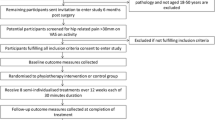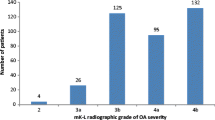Abstract
To the best of our knowledge, there is no study in the English literature about the usefulness of ultrasound therapy in degenerative hip osteoarthritis. The aim of this study was to examine its short- and long-term efficacy in patients with primary hip osteoarthritis with regard to pain, functional status, and quality of life (QoL). Forty-five patients with primary hip osteoarthritis were enrolled into the study. Demographic and clinical characteristics including age, sex, duration of disease, and pain on activity and at rest using visual analogue scale (VAS) were recorded. Functional status was determined by a 15-m timed walking test and Western Ontario McMaster Osteoarthritis Questionnaire. QoL was determined by the Short Form-36 survey (SF-36). Each patient was randomly assigned to either group I (standard physical therapy including hot pack and exercise program), group II (sham ultrasound in addition to standard physical therapy), or group III (ultrasound and standard physical therapy). The main outcome measures of the treatment were pain intensity by VAS; functional status measurements that were evaluated at baseline, at the end of the therapies, and at the first and third month of follow-up; and QoL scores that were determined at baseline and at the end of the first and third months. Twelve male and 33 female patients (mean age, 65.3 ± 6.7 years; mean disease duration, 2.5 ± 1.7 years) were included in the study. There were no differences between the groups regarding demographic variables on entry to the study. There were 15 patients in each group. Pain and functional outcome measures were determined to have improved significantly in all of the groups at the end of the therapies, but these improvements continued at the end of the first and third months only in group III (p < 0.001) The physical subscores of SF-36 were improved at the end of the first month and were maintained at the end of the third month only in patients receiving additional ultrasound therapy (group III, p < 0.001), while mental subscores of SF-36 did not change significantly in any group. In conclusion, addition of therapeutic ultrasound to the traditional physical therapy showed a longitudinal positive effect on pain, functional status, and physical QoL in patients with hip osteoarthritis. The use of therapeutic ultrasound in the treatment of hip osteoarthritis should be encouraged, and it seems worthy to continue with large clinical trials on ultrasound in order to standardize the treatment modality in this patient group.
Similar content being viewed by others
References
Woodward JL (2002) Hip osteoarthritis. In: Frontera WR, Silver JK (eds) Essentials of physical medicine and rehabilitation, vol 1. Hanley and Belfus, Philadelphia, pp 268–273
Basford JR (2005) Therapeutic physical agents. In: De Lisa JA (ed) Physical medicine rehabilitation principles and practice, 9th edn. Lippincott Williams and Wilkins, Philadelphia, pp 251–270
American College of Rheumatology Subcommittee on Osteoarthritis Guidelines (2000) Recommendations for the medical management of osteoarthritis of the hip and knee: update. Arthritis Rheum 43(9):1905–1915
Weber DC, Brown AW (2000) Physical agent modalities. In: Braddom RL (ed) Physical medicine and rehabilitation, 2nd edn. Saunders, Philadelphia, pp 413–439
Baker KG, Robertson VJ, Duck FA (2001) A review of therapeutic ultrasound: biophysical effects. Phys Ther 81:1351–1358
Van der Windt D, van der Heijden GJ, van den Berg SG et al (1999) Ultrasound therapy for musculoskeletal disorders: a systematic review. Pain 81:257–271
Gam AN, Johannsen F (1995) Ultrasound therapy in musculoskeletal disorders: a meta-analysis. Pain 63:85–91
Robinson VA, Brosseau L, Peterson J et al. (2001) Therapeutic ultrasound for osteoarthritis of the knee (review). Cochrane Database Syst Rev (3):CD003132
Robertson VJ, Baker KG (2001) A review of therapeutic ultrasound: effectiveness studies. Phys Ther 81:1339–1350
Srbely JZ (2008) Ultrasound in the management of osteoarthritis: part I: a review of the current literature. J Can Chiropr Assoc 52(1):30–37
Özgönenel L, Aytekin E, Durmuşoğlu G (2009) A double-blind trial of clinical effects of therapeutic ultrasound in knee osteoarthritis. Ultrasound Med Biol 35(1):44–49
Svarcova J, Trnavsky K, Zvarova J (1998) The influence of ultrasound, galvanic currents and shortwave diathermyon pain intensity in patients with osteoarthritis. Scand J Rheumatol Suppl 67:83–85
American Physical Therapy Association (1999) Guide to physical therapist practice: revisions. Phys Ther 79:623–629
Kellgren JH, Lawrence JS (1957) Radiological assessment of osteoarthrosis. Ann Rheum Dis 16:494–502
Altman RD (1991) The American Collage of Rheumatology criteria for the classification and reporting of osteoarthritis of the hip. Arthritis Rheum 34:505–14
Tüzün EH, Eker L, Aytar A et al (2005) Acceptability, reliability, validity and responsiveness of the Turkish version of WOMAC osteoarthritis index. Osteoarthritis Cartilage 13:28–33
Ware JE (2000) SF-36 health survey update. Spine 25(24):3130–3139
Hintze J (2001) NCSS and PASS. Number of Cruncher Statistical Systems. Kaysville, Utah. www.ncss.com
Weighl AF, Stucki G et al (2004) Inpatient rehabilitation for hip or knee osteoarthritis: 2 year follow up study. Ann Rheum Dis 63:360–368
French HP (2007) Physiotherapy management of osteoarthritis of the hip: a surgery practice in acute hospitals and private practice in the Republic of Ireland. Physiotherapy 93(4):253–260
Hernandes Molina G, Reichenbach ZB et al (2008) Effect of therapeutic exercise for hip osteoarthritis pain: results of a meta-analysis. Arthritis Care Res 59(9):1221–1228
French HP, Cusak T, Brennan A et al (2009) Exercise and manual physiotherapy arthritis research trial (EMPART): a multicentre randomised controlled trial. BMC Musculoskelet Disord 10:9
Falconer J, Hayes KW, Chang RW (1992) Effect of ultrasound on mobility in osteoarthritis of the knee. A randomised clinical trial. Arthritis Care Res 5:29–35
Deyle GD, Henderson NE, Matekel RL et al (2000) Effectiveness of manual physical therapy and exercise in osteoarthritis of the knee. Ann Intern Med 132(3):173–181
Angest F, Aeschlimann A, Steiner W, Stuck G (2001) Responsiveness of the WOMAC osteoarthritis index as compared with the SF-36 in patient with osteoarthritis of the leg undergoing a comprehensive rehabilitation intervention. Ann Rheum Dis 60:834–40
Jones JG, Leighton F (2002) Comparison of WOMAC with SF 36 for osteoarthritis of the knee or hip (letter). Ann Rheum Dis 61:182–183
McHugh GA, Luker KA, Campbell M et al (2008) Pain, physical functioning and quality of individuals awaiting total joint replacement: a longitudinal study. J Eval Clin Pract 14:19–24
Casarotto RA, Adamowski JC, Fallopa F, Bacanelli F (2004) Coupling agents in therapeutic ultrasound: acustic and thermal behaviour. Arch Phys Med Rehabil 85(1):162–5
Disclosures
None.
Author information
Authors and Affiliations
Corresponding author
Rights and permissions
About this article
Cite this article
Köybaşi, M., Borman, P., Kocaoğlu, S. et al. The effect of additional therapeutic ultrasound in patients with primary hip osteoarthritis: a randomized placebo-controlled study. Clin Rheumatol 29, 1387–1394 (2010). https://doi.org/10.1007/s10067-010-1468-5
Received:
Revised:
Accepted:
Published:
Issue Date:
DOI: https://doi.org/10.1007/s10067-010-1468-5




